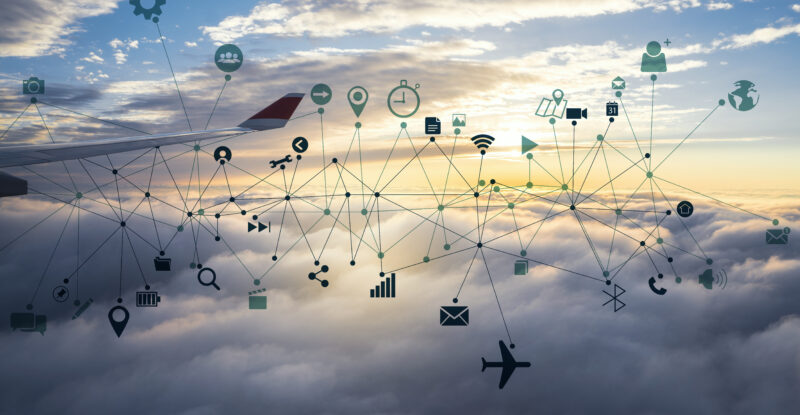Another day, another idiotically uninformed production from the generalist media about the passenger experience. This time, it’s Fast Company’s weekly video show The 29th Floor with executive editor Noah Robischon and senior writer Austin Carr having a know-nothing whinefest about inflight wifi.
“What does get old is crappy wifi on every flight I’ve ever been on,” starts Robischon, in what seems very much like a hit-piece on Gogo’s air-to-ground network.
It would seem that apparently Mr Robischon has never flown on an international flight with wifi, all of which use satellite connectivity. Nor has he evidently flown JetBlue, which has been rolling out fiber-speed ViaSat Ka-band satellite wifi to its A320 family fleet and is commencing installations on the Embraer E-190 fleet. Nor, clearly, United’s A320 family aircraft, its internationally configured planes (which have Panasonic Ku-band) or 737 jets (which have the same ViaSat system as JetBlue). Nor any Delta widebodies with satellite connectivity.
Fast Company inserts a section on how Gogo wifi can be up to $50 on the day, but makes no mention that if you purchase it in advance it can be significantly cheaper, nor indeed any mention of the supply and demand curve in the context of exponential connectivity demand that means Gogo has little choice with ATG and ATG-4 but to increase prices to reduce demand.
Austin Carr continues: “I think part of it is because people keep paying for this really, really terrible wifi. Wifi that you spend $50 each flight for, and it only works on your laptop but not on your phone, and people keep paying for it. So what’s the incentive for the airlines or for Gogo to make it better?” As if Gogo hasn’t spent the last few years developing technology like 2Ku to do precisely that.
“Apparently Virgin has started to implement something new,” Carr says, seemingly referring to Virgin America and not any of the international Virgin airlines. “The best part about it is that every time we’ve used the Internet in the past with Gogo, it’s mainly, as much as we’re paying, still just for checking email, surfing the web and things like that. But what Virgin is integrating is actually satellite wifi. That’s going to be high-speed Internet, you’re going to be able to stream Netflix on it, which is a promising sign.”
Satellite wifi was first flown in 2003 by Lufthansa and British Airways under the Connexion By Boeing brand. Lufthansa is still operating over fifty of the original CBB radomes today. Within the United States, JetBlue launched the ViaSat Ka-band system Virgin America will use — which Fast Company considers wildly futuristic, it seems — two years ago, in November 2013. Most of Southwest Airlines’ fleet is fitted with Global Eagle’s Ku satellite solution.
Risibly, Carr continues, “At some point, consumers will just realise that if I can get it for free over here, I’m more likely to fly with Virgin than I am with United, which historically is one of the worst providers of wifi.”
Carr is either troublingly uninformed, professionally negligent, or wilfully ignorant of easily verifiable facts. This information is simply a Google search away.
Of the three US legacy carriers, United has arguably the best inflight wifi offering, with that same ViaSat Ka-band system on its hundreds of Boeing 737 aircraft, plus Panasonic Ku on its A320 and international fleets. In the context of Fast Company’s attack on Gogo’s air-to-ground network, United has an exponentially higher proportion of aircraft with systems that can outperform Gogo ATG and ATG-4 than either American or Delta, or indeed any other airline apart from JetBlue. Virgin America is also not currently planning to roll out the Ka-band system onto its full fleet (it has selected satellite connectivity for a batch of 10 A320s).
Carr continues in his delusions: “My dream actually would be if I got on a flight and there was actually two wifi options: one for Gogo, one for a competitor or for two competitors. That would just force these people to say ‘you know what, if I want that $30 or $50 I have to earn it, and sort of create competition within the airline.”
If Carr thinks inflight connectivity is expensive now, just imagine if the potential revenue were split between multiple systems — let alone the cost and environmental impact of carrying multiple satellite radomes purely for competitive reasons. There might (might) be a point in the future where antennae are small enough and radomes low enough profile or integrated into the fuselage where this kind of local loop unbundling might make sense.
But it’s clear that neither Carr nor Robischon have the knowledge, expertise or professionalism to do any research whatsoever in this space to even start discussing the possibilities of such a move.
At the point where Carr said “if wifi becomes free on JetBlue and Virgin in the next year or so, probably all planes will have it”, we must confess to simply breaking down and laughing.
This Fast Company piece is simply the most recent in a lamentable trend of uninformed clickbait masquerading as journalism.
On the most recent episode of the Runway Girl Network PaxEx Podcast, RGN editor Mary Kirby put it best in a slightly different context: “People unknowingly click onto these articles… and the writers are not telling the other side of the story. It’s clickbaitable material.”
Fast Company, Noah Robischon and Austin Carr should be ashamed of broadcasting such an uninformed, unprofessional, badly researched and misleading segment.
Featured image credited to istock.com/ozgurdonmaz












